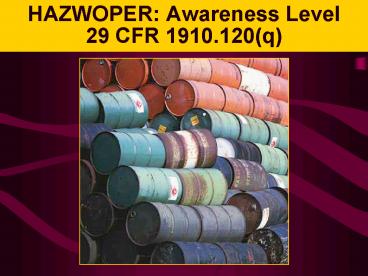HAZWOPER: Awareness Level 29 CFR 1910.120(q) - PowerPoint PPT Presentation
1 / 29
Title:
HAZWOPER: Awareness Level 29 CFR 1910.120(q)
Description:
Title: BLR s Safety Training Presentations Author: Chris & Kim DePoppe Last modified by: Larry R Harshbarger Created Date: 8/30/1999 12:42:14 AM – PowerPoint PPT presentation
Number of Views:1655
Avg rating:3.0/5.0
Title: HAZWOPER: Awareness Level 29 CFR 1910.120(q)
1
HAZWOPER Awareness Level29 CFR 1910.120(q)
2
Headline Stories
- Ammonia Evacuates Industrial Site
- Acid Spill Sends Workers to Hospital
- Fuel Spill Contaminate River
- Natural Gas Pipeline Ruptures
3
HAZWOPER Goals
- HAZWOPER and hazardous substances
- Awareness Level response
- Quiz
4
What Is HAZWOPER?
- Hazardous Waste Operations and Emergency
Response Required for facilities storing and
using hazardous chemicals - Defines emergency response procedures
5
HAZWOPER Basics
- Even a small spill can be dangerous
- Fires, explosions, and contamination can result
- Only trained workers clean spills
- Everyone must understand potential spill hazards
and their role in an emergency
6
Spill Prevention
- Understand chemical hazards
- Follow safe storage and handling procedures
- Read and follow the instructions on labels and
material safety data sheets - Dont use chemicals in unlabeled containers
7
Spill Prevention (cont.)
- Inspect chemical containers for damage or leaks
- Dont handle or open chemical containers
without PPE - Dont leave containers open
- Report potential hazards to your supervisor
8
Emergency Response Plan
- Pre-emergency planning and training
- Emergency recognition
- Evacuation procedures
- Emergency alerting and response
- PPE and emergency equipment
- Decontamination and medical treatment
9
Levels of Training
- First responder awareness level
- First responder operations level
- Hazardous materials technician
- Hazardous materials specialist
- Incident commander
10
Hazardous Substance?
- Includes pure or mixed chemicals and hazardous
wastes - Potential health hazards
- Could damage the environment
11
Recognize Chemical Substances
- Danger, caution, warning signs
- NFPA or HMIS labels
- DOT placards
12
Types of Chemicals
- Flammable or explosive
- Reactive
- Corrosive
- Toxic
13
Dangers of a Release
- Flammable liquids or gases
- Toxic cloud
- Reaction with nearby chemicals
- Irritants
14
Chemical Exposure
- Skin or eye contact
- Inhalation
- Swallowing
- Avoid contact and evacuate immediately
15
HAZWOPER Goals
- HAZWOPER and hazardous substances
- Awareness level response
- Quiz
16
Awareness Level Role
- Recognize a chemical release
- Determine chemicals identity
- Self-protection and protection of others
- Know how to get assistance
- Secure the area
17
Recognizing a Chemical Release
- Dripping or pool of liquid
- Unusual smell
- Unusual sound
- Loss of pressure or flow
18
Non-Hazardous Spills
- Incidental or small
- Handled by the employees in immediate area
- Get help if youre unsure
19
Identifying the Chemical
- Where is it coming from?
- Is the container labeled?
- Is it a liquid, gas, or solid?
- What does it smell like?
- What color is it?
20
Protect Yourself and Others
- Report the release to others in the immediate
area - Retreat to a safe distance, place of refuge, or
evacuation assembly area
21
Reporting the Spill
- Contact the emergency response coordinator
- Provide information
- Location of release
- Identity and quantity of spilled material
- Evacuation status
- Ask for instructions
22
Secure the Area
- Keep people a safe distance from the spill
- Use caution tape, rope, cones, etc.
- Stand guard of the controlled area
23
Response Personnel
- Analyze the incident
- Use proper PPE and equipment
- Contain the spill
- Stop the leak
- Clean up the spill
- Decontaminate
- Report the incident
24
HAZWOPER Goals
- HAZWOPER and hazardous substances
- Awareness Level response
- Quiz
25
Summary
- HAZWOPER is for facilities storing or using
hazardous chemicals - Practice spill prevention techniques
- Recognize the chemicals used at your facility
and know their hazards - Awareness Level personnel must
- Recognize a spill or release
- Know how to initiate a response
26
Quiz
- 1. Describe one way to recognize a chemical
release at your facility_________________________
_____________. - 2. The most likely chemical exposure during a
release is by inhalation. True or False - 3. How do you report the spill or release to
employees in the immediate area?
____________________________. - 4. Information provided to the emergency response
coordinator includes_ ___________________________.
- 5. Awareness Level personnel are trained to
contain or control a spill. True or False
27
Quiz (cont.)
- 6. Where is the evacuation assembly area?
____________________________________________. - 7. If the released substance is flammable,
ignition sources should be removed. True or
False - 8. The best way to identify a hazardous chemical
is by ____________________________________________
. - 9. Spill prevention can be achieved through
proper storage and handling. True or False - 10. Anyone can clean up small spills as long as
he or she is wearing gloves. True or False
28
Quiz Answers
- 1. Dripping or pool of liquid, unusual smell or
sound,drop in pressure or volume - 2. True
- 3. Yell or signal an alarm.
- 4. Location of release, identity and quantity of
spill, or evacuation status. - 5. False. Operations Level (one level above
Awareness Level) personnel are trained to control
and contain a spill in a defensive manner.
29
Quiz Answers (cont.)
- 6. The evacuation assembly area is specific to
each facility. - 7. True. Remove ignition sources by turning off
equipment, forklifts, etc. - 8. Identify a hazardous chemical by looking at
its labels, signs, or placards. - 9. True. Following proper storage and handling
procedures definitely helps prevent spills. - 10. False. Small spills of hazardous chemicals
can be very dangerous. If not trained, or
unsure, about a small spillcall for help.































